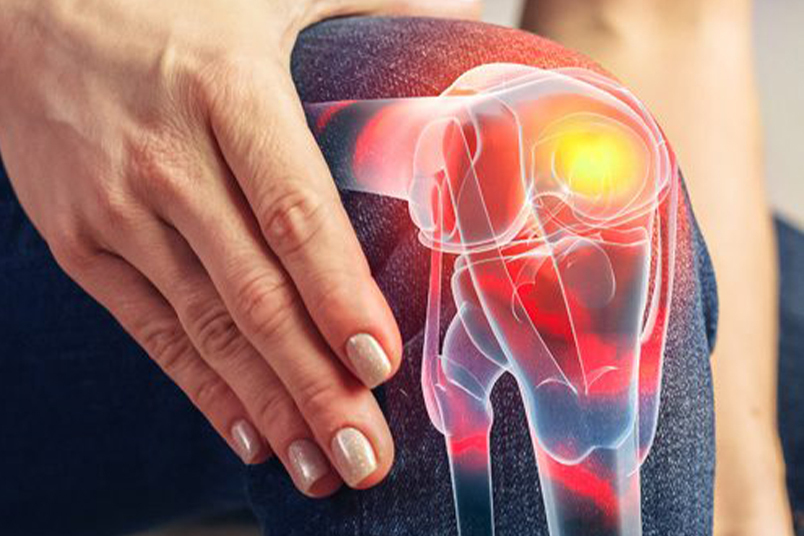Arthritis extends beyond the stereotype of being associated with older individuals and worn-out body parts. Regardless of age, whether it be 20, 30 or over 50, arthritis can affect anyone. It is important to understand that arthritis is more than just a general term for experiencing body aches and stiffness due to old age.
Arthritis encompasses more than a general diagnosis for individuals experiencing joint pain or related ailments.
Essentially, arthritis refers to inflammation occurring in one or multiple joints. Common symptoms include swelling, pain, soreness, stiffness, and restricted joint movement. These symptoms may fluctuate or persist as chronic conditions, gradually worsening over time and leading to increased severity and impairment.
In severe instances, arthritis can result in permanent changes to the affected joint.

The knee joint can be considered as a hinge joint, primarily responsible for the motion of bending and straightening. However, it is more intricate than a simple hinge, as the surfaces of the bones actually glide and roll against each other.
The knee joint is formed by the meeting of three bones: the femur (thighbone), the tibia, and the patella (kneecap). These bones are covered with smooth cartilage surfaces that act as a cushion during weight bearing activities.
Additionally, the bones of the knee are protected by a smooth and shiny layer called articular cartilage. They are also connected by strong ligaments and powerful muscles, which are attached to the thigh and calf through tendons, providing stability from side to side.
In a healthy knee, all of these structures work together, enabling the knee to smoothly flex (bend) and extend (straighten) the lower leg.
Common types of arthritis
There are many different kinds of arthritis, but common types that may affect your knees include:
Degenerative Arthritis:
Degenerative arthritis, also referred to as noninflammatory arthritis, is a type of arthritis that is characterized by the gradual deterioration of the joints.
Among the various forms of degenerative arthritis, osteoarthritis (OA) is the most prevalent. Compared to other types of arthritis, degenerative arthritis can be prevented or effectively managed with appropriate measures.
Osteoarthritis specifically occurs when the protective cartilage covering the ends of the joint bones gradually wears away, leading to friction between the bones. This process can result in weakened joints, impaired functionality, and persistent pain and stiffness.
In severe cases, individuals may require joint replacement surgery to alleviate the symptoms associated with osteoarthritis.
Inflammatory Arthritis:
Rheumatoid arthritis (RA) and psoriatic arthritis are the two most prevalent forms of inflammatory arthritis. When the immune system is functioning normally, it employs inflammation as a means to eliminate or prevent diseases and infections.
However, this same defense mechanism can backfire and cause the immune system to mistakenly target healthy tissues, leading to the deterioration of joints and major organs.
The development of this particular form of arthritis is believed to be a result of both genetic predisposition and environmental factors. Environmental factors, such as smoking, can trigger the inflammatory process.
Autoimmune arthritis is characterized by the way inflammation affects the body. Timely identification and an aggressive treatment strategy are essential in preventing irreversible joint impairment associated with these inflammatory/autoimmune conditions.
As the body's immune system inadvertently targets its own tissues, the resulting inflammation can inflict harm on internal organs, emphasizing the significance of prompt medical intervention.
The primary aim in addressing this particular type of arthritis is to attain remission. The conventional method for managing inflammatory arthritis includes corticosteroids or disease-modifying antirheumatic drugs (DMARDs) to suppress the immune system.
Infectious Arthritis:
Infections caused by organisms can give rise to arthritis. Infectious arthritis can be caused by various types of organisms that can affect the body. These organisms can originate from food poisoning or contamination, such as Salmonella or Shigella.
They can also be transmitted through sexually transmitted diseases like Chlamydia or Gonorrhoea. Additionally, a blood infection can occur through the sharing of needles or transfusion, as in the case of hepatitis C.
When an organism affects the joints, it is crucial to administer antibiotics promptly to eliminate the infection.
Metabolic Arthritis:
Certain types of arthritis can be caused due to the body's inability to effectively regulate natural waste products.
When purines, which are present in human cells and various foods, are broken down by the body, they form a compound known as uric acid. In some individuals, the levels of uric acid are elevated to such an extent that the body struggles to eliminate it efficiently.
Consequently, the accumulation of excessive uric acid can lead to the formation of needle-like crystals within the joints, resulting in severe bouts of joint pain and inflammation.
The most prevalent form of metabolic arthritis is Gout, which can manifest as intermittent attacks or become a chronic condition if the levels of uric acid are not properly managed and reduced.
Treatment for knee arthritis
The management of knee arthritis usually includes a blend of lifestyle adjustments, medications, and physical therapy.
Non-steroidal anti-inflammatory drugs (NSAIDs) can effectively alleviate pain and inflammation, whereas corticosteroid injections may offer temporary relief. Physical therapy concentrates on strengthening the muscles surrounding the knee to enhance stability.
Maintaining a healthy weight is vital to minimize strain on the joint. In more severe instances, surgical alternatives such as arthroscopy or joint replacement might be considered.
To conclude, the management of knee arthritis requires a comprehensive approach that takes into consideration its multifaceted causes. Personalized treatments, encompassing rest, physical therapy, medical interventions, and lifestyle modifications, are aimed at reducing pain and restoring knee function.
By consulting professionals, individuals can obtain an accurate diagnosis and effectively manage the condition, thereby playing a crucial role in preserving joint health in the long term.
KM NU Hospitals, Ambur is renowned for its cutting-edge orthopaedic facilities that offer a wide range of services for the treatment of knee arthritis. Our team of highly skilled orthopaedic professionals and dedicated staff are committed to providing continuous support and guidance to patients throughout their treatment journey. We prioritize delivering personalized care of the utmost quality, tailored to meet the unique needs of each individual.
References:
1. Arthritis of the Knee. OrthoInfo. https://orthoinfo.aaos.org/en/diseases--conditions/arthritis-of-the-knee/.
2. Knee Arthritis. JOHNS HOPKINS MEDICINE. https://www.hopkinsmedicine.org/health/conditions-and-diseases/knee-arthritis.
3. When Knee Pain May Mean Arthritis. Arthritis Foundation. https://www.arthritis.org/health-wellness/about-arthritis/where-it-hurts/when-knee-pain-may-mean-arthritis.
4. Arthritis of the Knee. Cleveland Clinic. https://my.clevelandclinic.org/health/diseases/21978-arthritis-of-the-knee.
Author: Dr. Allen Sunny Deol.S.V
